Exploring Flower Stands: Design and Functionality
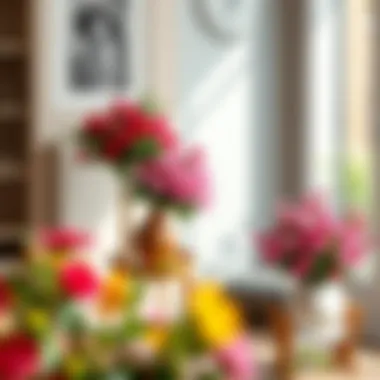

Intro
Flower stands are more than mere holders for plants; they are integral pieces in the tapestry of home and commercial decor. Whether gracing a windowsill, standing in the corner of a cozy living room, or occupying a prominent spot in a bustling cafe, flower stands can elevate the overall aesthetic of a space. They balance functionality and beauty, making them sought after by homeowners, interior designers, and decorators alike.
As trends evolve, so too does the design of these stands. From modern minimalism to vintage charm, the styles available cater to a variety of tastes and settings. Furthermore, the materials used in crafting these stands have expanded significantly. Now, they're not just limited to classic wood or metal; the innovation of sustainable materials and smart technology is reshaping what we consider traditional.
In this exploration, we will dive into the current design trends, the innovative materials reshaping how stands are made, and offer practical tips for integrating flower stands into any environment. By the end, readers will find themselves armed with knowledge to select and display these functional art pieces in a way that truly reflects their style and personality.
Design Trends
The realm of flower stands is buzzing with creativity. Homeowners and designers are actively seeking ways to incorporate these elements into their spaces, making it essential to understand the prevailing trends that define their aesthetic appeal.
Contemporary Styles
The contemporary design landscape is awash with sleek lines and functional forms. Modern flower stands often emphasize minimalism, focusing on simplicity and elegance. Look for stands with geometric shapes or those that utilize open frameworks to give an airy feel. Materials like glass or polished metal are quite popular, as they bring a contemporary edge to space. Designs that seamlessly fit into loft-style apartments or modern homes showcase how functional decor can simultaneously be chic.
A noteworthy example of a contemporary stand would be the String Shelf, which balances function and artistry. Its simple yet effective design captivates users by allowing plants to take center stage without overwhelming their surroundings.
Vintage Inspirations
On the flip side, vintage-inspired designs tell a story that often attracts those who appreciate the history and charm of bygone eras. Whether it’s a weathered wooden stand or an ornate wrought iron design, vintage stands can evoke feelings of nostalgia. Imagine a stand made from reclaimed wood, adorned with antique brass fixtures, bringing warmth and character to a minimalist room.
The intricate carvings on an Art Nouveau stand can serve as a conversation starter. These designs often reflect nature, with flowing lines that mimic tree branches or flower petals, bridging the gap between flora and furniture.
Material Innovations
Material choices in the crafting of flower stands have broadened dramatically, influencing style, durability, and ethical implications. Designers are increasingly drawn to materials that not only look good but are also sustainable and practical.
Sustainable Materials
Sustainability in design is more than just a trend; it’s a responsibility. Flower stands made from eco-friendly materials like bamboo or recycled metals showcase an important shift towards greener living. Bamboo products are lightweight, durable, and renewable, making them perfect for modern designs that prioritize sustainability without sacrificing style.
Furthermore, those interested in more unconventional materials might explore stands crafted from reclaimed wood or even plastic waste, shining a light on how creativity can also be environmentally conscientious.
Smart Furniture Technology
The integration of technology into furniture design has also found its way into flower stands. Some products now come with built-in sensors that can monitor the moisture level of the soil, ensuring plants get the precise care they need without a hitch. These smart stands can even sync with apps on smartphones, sending reminders for watering or providing tips on maintaining plant health. Such innovations not only enhance the functionality but also cultivate a connection between users and their plants, enriching the experience of nurturing greenery.
"With the right flower stand, you can turn a simple plant into a captivating focal point that enhances the entire room's atmosphere."
Foreword to Flower Stands
Flower stands are more than just decorative objects; they are the silent storytellers in our living spaces. Their ability to enhance the ambiance of a room while serving a functional purpose makes them a captivating subject for both homeowners and professionals in the design realm. It's not merely about placing a vase on a table; it's about creating an experience, setting the stage for nature's beauty to shine through. Understanding flower stands thus proviides insight into how these pieces can influence interior aesthetics and emotional well-being.
Definition and Purpose
A flower stand, in its essence, is a structure designed to hold and display flowers or plants. However, their purpose extends beyond just that. They can act as artistic installations, functional room dividers, or focal points in both residential and commercial settings. Whether one is trying to add a splash of color to a dreary corner or aiming to create a peaceful oasis filled with greenery, flower stands play a pivotal role. They enable the arrangement of flora in various heights and designs, highlighting the natural beauty while maintaining a balance within the space. This adaptability makes them indispensable for decorators and designers alike.
Historical Context
The history of flower stands reflects the evolution of interior design itself. From ancient civilizations where elaborate flower arrangements adorned the homes of the elite, to the more modern minimalist styles that favor simplicity and functionality, these stands represent changing tastes and trends. In fact, ancient Egyptians were known to use elaborate vases and stands to display their flora, showcasing their religious significance. During the Victorian era, flower stands became a symbol of status, often ornate in design and a common feature in the homes of the affluent. Today, with the rise of sustainability, many flower stands are crafted from recycled materials, reflecting a deeper awareness of environmental issues. Their journey through time illustrates not just an ornamental purpose but a cultural dialogue, showcasing how we relate to nature within our living spaces.
"Flower stands are a window into the soul of a home, blending artistry with functionality, shaping our connection to nature in everyday life."
The exploration of flower stands offers valuable insights for a range of audiences, from homeowners looking to enhance their personal sanctuaries to professional decorators seeking innovative solutions. Throughout this article, we dive deeper into the various types, materials, design trends, and care tips for flower stands and how to integrate them seamlessly into your home or workspace. Understanding these elements can enrich one's approach to interior design, fostering a setting that is not just aesthetically pleasing but also deeply resonant.
Types of Flower Stands
Understanding the different types of flower stands is crucial for anyone looking to enhance their space with floral beauty. Each type serves a unique purpose, enabling users to showcase plants and flowers in ways that resonate with their personal style. By identifying the best type for a particular setting, homeowners, interior designers, or decorators can significantly impact the ambiance and functionality of a space. Furthermore, the choice of flower stand is not merely about aesthetics; it also considers practical aspects like size, material, and placement. This section breaks down the various kinds of flower stands available, assisting you in making an informed decision.
Tabletop Flower Stands
Tabletop flower stands are a popular choice for those who want to add a touch of greenery to smaller spaces. These stands are generally compact, making them ideal for countertops, windowsills, or even coffee tables. Their small footprint allows flexibility in positioning while still having a significant visual impact.
When selecting a tabletop stand, consider the height and width of your chosen flowers or plants. A stand that elevates the foliage can create an illusion of depth, especially with larger blooms. For instance, using a metal wire stand to display a cluster of vibrant succulents not only draws the eye but also adds a modern twist to a traditional setting. Besides their aesthetic appeal, tabletop stands are often lightweight, making them easy to rearrange as seasons or occasions change.
Floor Flower Stands
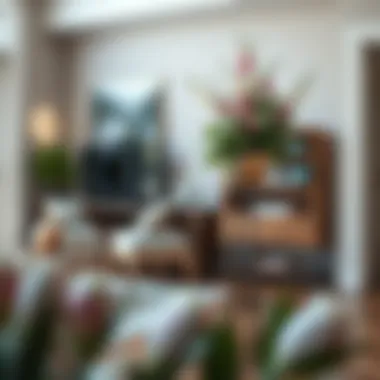

Floor flower stands, as the name suggests, are larger structures that reside directly on the ground. They are well-suited for spaces that can accommodate larger configurations, offering dramatic displays that can be focal points in any room. From simple designs made of wood to elaborate wrought iron models, the diversity in style is immense.
A fundamental benefit of floor stands is their versatility. They can serve as standalone pieces or complement existing furniture. For example, a tall wooden floor stand adorned with cascading vines can create an inviting atmosphere in an entryway or living room. Additionally, these stands often provide more weight, making them less prone to tipping over, especially if they hold bulkier plants.
Wall-mounted Flower Stands
Wall-mounted flower stands are an ingenious solution for maximizing vertical space. They appeal particularly to urban dwellers where floor space is at a premium. By utilizing the wall, you can free up valuable floor area, all while creating a stunning vertical garden or a simple display of florals.
These stands come in various materials, from sleek metals to rustic wood, allowing for personal expression. They can be arranged in patterns to form artistic displays or aligned for a more structured look. A noteworthy concept is to suspend them at different heights, allowing trailing plants like philodendrons to overflow and create a beautiful cascading effect. The depth that wall-mounted stands add can dramatically influence the room's design, making walls come alive with color and texture.
Hanging Flower Stands
Hanging flower stands lend a whimsical touch to any setting. They are especially suited for those who appreciate an airy feel or want to experiment with height in their decor. Using ceiling hooks or wall brackets to suspend flower stands opens up new opportunities for unique design expressions.
One standout feature of hanging stands is that they can emphasize lightness. For instance, using a handmade macramé hanger to cradle a ceramic pot filled with bright flowers creates a stunning focal point in a sunlit spot. These stands can also be strategically positioned to enhance a two-dimensional space, allowing the eye to be drawn upwards in the room. Whether indoors or out, hanging flower displays can add vibrancy and creativity to any environment.
"Flower stands serve as not just holders for plants, but as an extension of one's personal style and a means to express creativity in interior design."
Materials Used in Flower Stands
When it comes to choosing a flower stand, the materials used can make or break the overall functionality and aesthetic of the piece. It’s not only about how the stand looks but also about how well it supports and showcases the flowers themselves. Different materials bring unique benefits and considerations that can significantly impact the decision-making process for homeowners, decorators, and DIY enthusiasts.
Wooden Flower Stands
Wooden flower stands have a timeless charm that can blend seamlessly into many decor styles, from rustic to modern. They often evoke a sense of warmth and organic beauty, making them ideal for both indoor and outdoor settings.
- Durability: Well-cared for wooden stands can last for decades, often growing more beautiful with age.
- Customization: Wood can be painted or stained to match existing furniture, which means versatility is at your fingertips.
- Natural Insulation: For outdoor use, wooden stands provide insulation for the plants against rapid temperature changes.
However, one should consider the type of wood being used; some woods are more susceptible to rot and pests. The right treatment and maintenance are key to longevity.
Metal Flower Stands
Metal flower stands inject a touch of contemporary flair into any space. With options ranging from wrought iron to aluminum, metal can provide strength while offering an array of design possibilities.
- Strength and Stability: These stands are often able to hold heavier plant arrangements without the risk of tipping over.
- Weather Resistance: Metal options like stainless steel are particularly resistant to the elements, suitable for outdoor gardens or patio settings.
- Sleek Aesthetic: Their minimalist look can enhance modern and industrial interiors.
Nevertheless, metal can get quite hot in direct sunlight, which may not be ideal for all plant types. A consideration for placement is essential to ensure the health of the flowers.
Plastic and Acrylic Stands
Plastic and acrylic stands are known for their lightweight nature and affordability. This makes them an excellent choice for those looking for budget-friendly yet stylish flower display options.
- Variety of Color: They come in a multitude of colors and designs, perfect for those wanting to add vibrant pops to their space.
- Lightweight: These stands can be easily moved around, allowing for flexibility in arrangements.
- Easy Maintenance: Cleaning is straightforward, often requiring just a wipe down with a damp cloth.
However, they may not offer the same level of durability or aesthetic prestige as natural materials like wood or metal.
Glass Flower Stands
Glass flower stands bring an elegant touch to any environment, allowing for a beautiful view of the flowers from all angles. They can be used effectively in both formal and casual settings.
- Transparency: This material creates an illusion of space, ideal for smaller rooms or compact areas.
- Refined Look: Glass conveys sophistication and works well in modern decor themes.
- Compatibility: It pairs beautifully with a variety of other materials, such as wood and metal.
But there are some cautions: glass can be fragile and careful handling is necessary. They often require more careful cleaning to avoid streaks or smudges.
"Choosing the right material for your flower stand can radically impact both the appearance and functionality of the display."
When selecting a flower stand, consider the specific traits of each material. Reflect on where the stand will be placed, the type of flowers to be displayed, and the overall theme or aesthetic of the space. Each material has its own set of characteristics that can either complement or detract from your floral arrangement, and understanding these nuances will help you make an informed choice that aligns with your vision.
- Key Considerations:
- Durability: Will it withstand the test of time?
- Maintenance: How much care does the material need?
- Style: Does it match your existing decor?
A well-chosen flower stand can elevate any floral display, making it more than just a container. It becomes a statement piece that can define a room.
Design Trends in Flower Stands
In the ever-evolving landscape of interior design, flower stands have carved a niche for themselves, transitioning from mere holders of flora to artistic expressions that elevate spaces. They are more than simple supports; they’re integral elements that can harmonize the aesthetic of a room. Recognizing and understanding design trends in this realm is crucial for anyone looking to enhance their living or working environments. From the choice of materials to the style, every aspect plays a role in how a flower stand can impact the overall character of a space. Let’s explore four prominent trends shaping flower stands today.
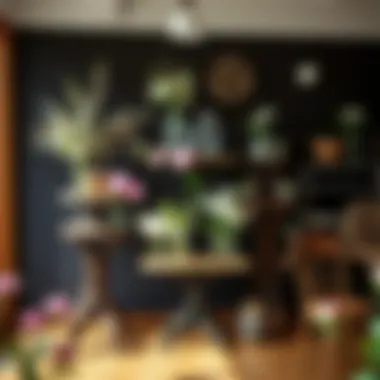

Minimalist Designs
Minimalism, characterized by simplicity and functionality, has permeated many areas of design, including flower stands. This trend focuses on clean lines, uncluttered forms, and an overall aesthetic that avoids excess. Minimalist flower stands often feature sleek materials like metal or wood with natural finishes. The beauty lies in their understated elegance, making them a perfect choice for modern and contemporary settings.
Benefits of Minimalist Designs:
- Versatility: Easily integrate into various styles without clashing.
- Easy Maintenance: Fewer embellishments mean less to clean.
- Space-Optimizing: Often compact, they suit smaller areas well.
When using minimalist flower stands, it's essential to choose plants that create a striking visual contrast. Think of a monstera or a snake plant, which can provide a lush green pop against the simplicity of the stand’s form.
Vintage and Rustic Styles
Embracing nostalgia, vintage and rustic flower stands are proving that some trends never truly fade. These stands often showcase craftsmanship, using reclaimed wood or wrought iron to invoke a sense of history and warmth. Decorating with these stands adds personality and character, ideal for creating cozy atmospheres in homes or cafes.
Incorporating vintage designs offers various aesthetic benefits:
- Warmth: They bring a homely feel, resonating comfort and charm.
- Unique Pieces: Often one-of-a-kind, they provide storytelling opportunities.
- Sustainability: Using reclaimed materials aligns with eco-friendly practices.
For a rustic look, complement the flower stand with wildflowers or dried arrangements, creating an organic feel that resonates with nature.
Art Deco Inspirations
Art Deco, with its bold geometry and luxurious finishes, is experiencing a renaissance in flower stand design. This trend focuses on sophisticated aesthetics, with stands featuring intricate patterns and rich materials such as polished brass or lacquered wood. These stands are not just functional; they serve as sculptural pieces that command attention and add glamour to any space.
Key Elements of Art Deco Flower Stands:
- Bold Colors: Rich hues capture the eye, perfectly showcasing vibrant blooms.
- Geometric Shapes: Symmetrical designs enhance the visual appeal.
- Luxury Materials: Brass and glass lend an opulent touch to decor.
They fit wonderfully in both residential interiors and commercial spaces like boutiques, where they can create a backdrop for stunning floral arrangements that match the ornate style of the stand itself.
Contemporary Innovations
In the present day, innovation has taken the forefront in flower stand designs, marrying technology with aesthetics. Contemporary stands often incorporate smart designs that allow for adaptability, such as adjustable heights or modular components. Many brands offer stands with integrated LED lighting, enhancing the display of florals while making a statement on modern trends.
Such innovative designs bring forth numerous advantages:
- Functionality: Multi-purpose uses cater to varying needs within a space.
- Eco-friendly Materials: Many are crafted from sustainable resources, appealing to environmentally conscious consumers.
- Interactive Features: Some stands include sensors that improve plant care, like reminders to water or adjust lighting.
Incorporating these kinds of innovative stands can not only improve the visual appeal of a space but also cater to the practical needs of plant care in an increasingly busy world.
"Every flower stand tells a story; its design reflects the essence of its surroundings as much as the blooms it cradles."
Understanding these design trends in flower stands equips homeowners and decorators alike with the knowledge necessary to select pieces that deeply resonate with their personal or brand identity.
Functionality and Placement
When it comes to flower stands, the functionality and placement play a pivotal role in fully realizing their potential within a space. These decorative holders are more than just pretty accents; their strategic placement can either amplify the aesthetic appeal of a room or render it less enchanting. The balance of style and practicality is key, as flower stands not only showcase floral arrangements but also contribute to the overall harmony and flow of interior design. Understanding how to effectively position these stands can lead to a more inviting atmosphere, making it essential to consider various factors before committing to their placement.
Choosing the Right Location
Selecting the perfect spot for a flower stand involves more than just fulfilling an aesthetic desire; it's about enhancing the environment. Start by observing the natural light in a room. Plants thrive in well-lit areas. Placing your flower stand near a window can not only provide adequate sunlight for the blooms but can also create a beautiful, refreshing focal point. Think about the nature of the room as well. A vibrant flower stand in a neutral space can create a stunning contrast, while softer arrangements in more colorful rooms can complement existing decor.
Key Considerations
- Traffic Flow: Avoid placing flower stands in high-traffic areas where they might get knocked over.
- Height and Proportion: Ensure that your stand is proportionate to the surrounding furniture; a tall stand in a small room can overwhelm the space.
- Accessibility: Make sure the arrangement is low-maintenance and easy to water and tend to.
It’s also prudent to consider the material of the flower stand. Lightweight designs can be easily moved to find the right spot when you're experimenting with placements. The ability to shift them around can help you find that sweet spot where functionality meets beauty.
Balancing Aesthetics and Utility
Striking a balance between aesthetic appeal and utility is the heart of successful flower stand placement. It’s not just about how good a stand looks but also how effectively it works within the context you place it in. For instance, a beautifully crafted wooden stand can bring warmth to a space but might also need to be positioned where its beauty can shine without becoming a nuisance.
Here are some tips to maintain this balance:
- Consider Multi-functionality: Choose stands that can serve dual purposes, like those that include storage to hold pots or gardening tools; this adds both beauty and practicality.
- Harmonize with Decor: Ensure that the flower stand complements the existing furniture styles and colors to avoid a jarring effect. A sleek metal stand may not resonate with a rustic-themed room.
- Seasonal Adjustments: Don’t be shy about changing locations based on the season. Some flowers thrive in specific conditions that might not be present in every room or at every time of the year. Moving stands to different locations or swapping out arrangements can keep the decor dynamic.
"A well-placed flower stand doesn't just support plants; it holds the space together, creating connections between elements that might otherwise feel disjointed."
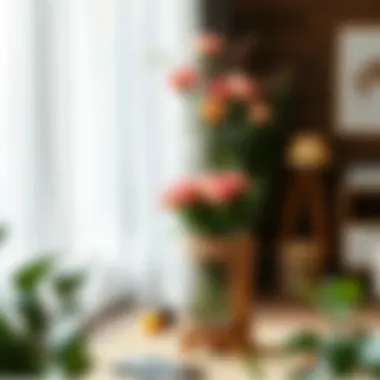
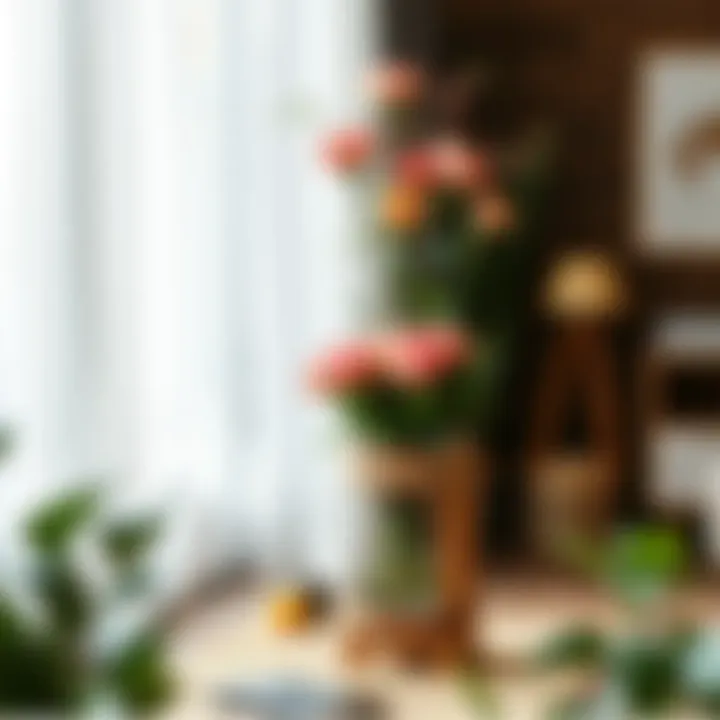
In summary, understanding the nuances of functionality and placement in flower stands can greatly influence the energy and aesthetics of a space. By considering natural light, traffic patterns, and material practicality, you can create harmonious living environments that elevate the ordinary to extraordinary.
Caring for Flower Stands
Caring for flower stands is not merely a process to keep them looking pretty; it's about enhancing their lifespan, ensuring their aesthetic value is maintained, and promoting a healthier environment for the plants they support. Flower stands, when well cared for, can serve as stunning focal points in any home or office, blending functionality with artistry.
To keep your flower stands in tip-top shape, one must consider various factors, such as the material of the stand, the types of plants being housed, and the environment they are placed in. After all, a neglected flower stand cloaked in dust can turn from a striking centerpiece to an eyesore in no time. Here’s where understanding how to maintain them becomes crucial.
Maintenance Tips by Material
Different materials require varied approaches to maintenance. Knowledge is power, and here’s how to tackle care based on what your flower stand is made from:
- Wooden Flower Stands: Wood can be susceptible to moisture and pests. Use a gentle wood cleaner regularly and avoid water pooling on the surface. Waxing once every few months can protect against scratches and keep the grain looking sharp.
- Metal Flower Stands: These can corrode if exposed to moisture. Check for rust spots and address them promptly. Utilize a soft cloth with metal cleaner and polish to keep them shining. If your stand has a powder coating, make sure to treat it with care to prevent scratches.
- Plastic and Acrylic Stands: Simple but effective! Wipe them down with a damp cloth; avoid abrasive materials that could scratch the surface. Some gentle dish soap won’t hurt, either, especially for stubborn stains.
- Glass Flower Stands: They need a bit of affection. Regularly dust them with a microfiber cloth, and use glass cleaner for smudges. Be cautious about heavy plants; if the glass is not tempered, it could be prone to cracking.
Quick Reference Guide:
| Material | Maintenance Tips | | Wooden | Clean with wood cleaner; apply wax regularly. | | Metal | Use metal cleaner; avoid corrosion by drying. | | Plastic/Acrylic | Wipe with damp cloth; avoid abrasives. | | Glass | Dust with microfiber; use glass cleaner. |
Cleaning and Upkeep
Regular cleaning and upkeep can not only keep your flower stands looking fresh but also ensure that the plants are thriving. Dust and debris can accumulate quickly, especially in high-traffic areas. A few simple steps can keep your flower stands functioning optimally:
- Routine Dusting: Make it a habit to dust your flower stands weekly. This simple act prevents grime and buildup.
- Regularly Moving Plants: Occasionally lift your plants to check if the stand is accumulating dirt underneath. This gets missed but is crucial to overall cleanliness.
- Monitor for Pests: Check both the plants and the stands for any signs of pests. If you notice any intruders, tackle them immediately with appropriate treatments.
- Winter Care: If the stands are outdoors, ensure they’re cleared of snow and ice, especially for wooden and metal stands, to prevent long-term damage.
- Seasonal Refresh: Periodically switching out plants and giving the stand a thorough clean can reboot its appeal and keep your decor fresh.
As the old saying goes, "An ounce of prevention is worth a pound of cure." By incorporating these practices, homeowners and decorators can ensure their flower stands remain as beautiful and functional as the day they were bought. In a world where design continuously evolves, it’s crucial to keep up with your pieces to maintain the harmony in your spaces.
"A flower stand is not just decor; it’s a living representation of nature’s beauty in our daily lives."
By paying attention to the specific care needs of materials and committing to routine maintenance, you can guarantee that your flower stands continue to enhance your living areas, bringing life and color into your surroundings.
Impact on Interior Design
In the realm of interior design, flower stands embody more than just functional pieces; they serve as vital elements that breathe life into a space. Their capacity to enhance aesthetics is undeniable, offering a marriage of utility and beauty. Whether you’re a homeowner eager to infuse your living quarters with a touch of nature or a designer aiming to elevate a commercial environment, understanding the impact of flower stands is crucial. They not only provide a home for blooms but also create focal points, guide foot traffic, and rejuvenate the atmosphere of a room.
One cannot overlook the versatility of flower stands. Here are a few compelling reasons why they hold significance in enhancing the decor:
- Visual Cohesion: By strategically placing flower stands at intervals throughout a space, one can achieve visual balance. This makes the arrangement of furniture and other elements feel more purposeful.
- Mood Enhancement: Well-placed flower stands filled with vibrant plants can uplift spirits and promote well-being. Plants are known to reduce stress and improve mental clarity, making their presence in a room invaluable.
- Personal Expression: Flower stands provide a medium for individuals to showcase their personality. Choosing the right type of stand and blooms can reveal a lot about one's style, preferences, and even mood.
- Zoning: In open plan areas, flower stands can assist in defining spaces, effectively acting as barriers that do not feel restrictive while still marking transitions between different functions of the area.
"A little flower stand can transform a mundane corner into a vibrant oasis, making it the heartbeat of your decor."
For anyone looking to incorporate these standouts into an interior design scheme, considering the overall theme of the space is paramount. Floral arrangements should echo other design elements, and the flower stand itself should align with the color palette and style, whether it’s sleek metal for a modern edge or rustic wooden stands for a cozy feel. The thoughtful selection of stands and plants can ultimately dictate the energy of the room, leading to a harmonious design.
Enhancing Ambiance in Living Spaces
In living spaces, ambiance is everything. The right flower stands can act as catalysts that elevate an otherwise bland area into a sanctuary. Picture a sunlit corner of your living room adorned with a chic white metal stand showcasing cascading greenery; it creates an inviting vibe, where guests feel welcome to linger. Effective use of flower stands influences how people interact with their environment, inviting calmness and contentment.
To enhance ambiance, consider these approaches:
- Layering Heights: Utilize varying heights in flower stands to create visual intrigue, making the space feel dynamic rather than flat.
- Seasonal Adjustments: Change the arrangements with the seasons. Bright, lively blooms in spring can give way to deeper hues in the fall, keeping the atmosphere fresh and ever-evolving.
- Lighting: Position flower stands near natural light sources or use soft spotlighting, drawing attention to plants while highlighting their textures and colors.
Utilizing Flower Stands in Offices
Office environments can often feel sterile and uninspired, making flower stands an excellent solution to inject life and color. By incorporating greenery into the workspace, one can turn a gray cubicle into a vibrant zone that encourages creativity and productivity. Flower stands can capitalize on vertical space, allowing for greenery without taking up valuable floor space.
A few tips for integrating flower stands in office settings include:
- Desk Accessories: Small, desktop flower stands with succulent arrangements can create personal workspaces that motivate and inspire.
- Reception Areas: Larger floor stands in reception can impress visitors and clients, creating a warm and welcoming first impression.
- Meet Spaces: Utilize contemporary flower stands to enhance collaboration areas, framing discussion zones with organic shapes that promote open conversation.
Closure
In wrapping up this comprehensive exploration into flower stands, it's essential to recognize not just their aesthetic charm but also their underlying functionality. Flower stands, as we’ve seen, do more than merely hold plants; they play a pivotal role in elevating the design narrative of any space, whether residential or commercial. By thoughtfully integrating these stands, homeowners and designers alike can enhance the ambiance, turning ordinary settings into vibrant displays of nature and creativity.
The Future of Flower Stands
Looking ahead, the future of flower stands appears promising. As sustainability becomes more critical, many designers are embracing eco-friendly materials and practices. We can expect to see an uptick in flower stands made from recycled or upcycled materials, promoting an environmentally conscious lifestyle. Additionally, with technology rapidly advancing, we might witness smart flower stands that can monitor plant health or even adjust water levels automatically.
Moreover, the trend towards personalized and customized designs is likely to gain traction. Individuals might gravitate towards making their flower stands reflect personal tastes and styles, steering away from mass-produced options. In this regard, flower stands will not just be furniture; they’ll be statements, telling stories about the owners and their spaces.
Inspiration for Your Own Designs
For those looking to weave flower stands into their environments, inspiration can be drawn from a myriad of sources. Here are some pointers:
- Nature: Observe how flowers and plants grow naturally. This can guide the form and style of your stand. Natural curves and organic shapes can offer a refreshing twist.
- Cultural Influences: Different cultures have unique approaches to plant displays. From Japanese Ikebana to European floral arrangements, these can inspire diverse design aesthetics.
- DIY Projects: Don't shy away from personal projects. Combine various materials—wood, metal, and textiles—to craft something truly unique.















